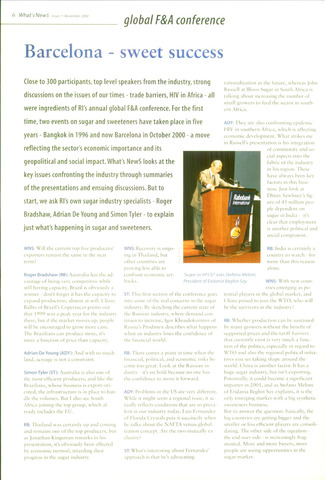global F&A conference
Barcelona - sweet success
6 What'sNewS
Close to 300 participants, top level speakers from the industry, strong
discussions on the issues of our times - trade barriers, HIV in Africa - all
were ingredients of RI's annual global F&A conference. For the first
time, two events on sugar and sweeteners have taken place in five
years - Bangkok in 1996 and now Barcelona in October 2000 - a move
reflecting the sector's economie importance and its
geopolitical and social impact. What's NewS looks at the
key issues confronting the industry through summaries
of the presentations and ensuing discussions. But to
start, we ask RI's own sugar industry specialists - Roger
Bradshaw, Adrian De Young and Simon Tyler - to explain
just what's happening in sugar and sweeteners.
Issue 7 November 2000
WNS: Will the current top five producers/
exporters remain the same in the near
term?
Roger Bradshaw (RB): Australia has the ad-
vantage of being very competitive while
still having capacity. Brazil is obviously a
winner - don't forget it has the capacity to
expand production, almost at will. Clésio
Balbo of Brazil's Copersucar points out
that 1999 was a peak year for the industry
there, but if the niarket moves up, people
will be encouraged to grow more cane.
The Brazilians can produce more, it's
more a function of price than capacity.
Adrian De Young (ADY): And with so much
land, acreage is not a constraint.
Simon Tyler (ST): Australia is also one of
the most efficiënt producers, and like the
Brazilians, whose business is export-ori-
ented, the infrastructure is in place to han-
dle the volumes. But I also see South
Africa joining the top group, which al-
readv includes the EU.
RB: Thailand was certainly up and coming
and remains one of the top producers, but
as Jonathan Kingsman remarks in his
presentation, it's obviously been affected
by economie turmoil, retarding their
progress in the sugar industry.
WNS: Recovery is ongo-
ing in Thailand, but
other countries are
proving less able to
confront economie set
backs.
rationalization as the future, whereas John
Russell at lllovo Sugar in South Africa is
talking about increasing the nuntber of
small growers to feed the sector in south-
ern Africa.
ADY: They are also confronting epidemie
HIV in southern Africa, which is affecting
economie development. What strikes me
in Russell's presentation is his integration
of community and so
cial aspectsinto the
fabric of the industry
in his region. These
have always been key
factors in this busi
ness. Just look at
Dhruv Sawhney's fig-
ure of 45 million peo
ple dependent 011
sugar in India - it's
clear that employment
is another political and
social component.
RB: India is certainly a
country to watch - for
more than this reason
alone.
'Sugar or HFCS?'asks Stefano Meloni,
President ofEridania Beghin Say
ST: This first section of the conference goes
into some of the real concerns in the sugar
industry. By sketching the current state of
the Russian industry, where demand con-
tinues to increase, Igor Khoudokormov of
Russia's Prodimex describes what happens
when an industry loses the confidence of
the financial world.
RB: Th ere cornes a point in time when the
financial, political, and economie risks be-
come too great. I.ook at the Russian in
dustry - it's on hold because no one has
the confidence to move it forward.
ADY: Problems in the US are very different.
While it might seem a regional issue, it ac-
tually reflects conditions that are so preva
lent in our industry today. Luis Fernandez
of Florida Crystals puts it succinctly when
he talks about the NAFTA versus global-
ization concept. Are the two mutually ex-
clusive?
ST: What's interesting about Fernandez'
approach is that he's advocating
WNS: With new coun
tries emerging as po-
tential players in the global market, and
China poised to join the WTO, who will
be the survivors in the industry?
RB: Whether production can be sustained
by many growers without the benefit of
supported prices and the tariff barriers
that currently exist is very much a func
tion of the politics, especially in regard to
WTO and also the regional political initia-
tives you see taking shape around the
world. China is another factor. It has a
huge sugar industry, but isn't exporting.
Potentially, it could become a significant
importer in 200 I, and as Stefano Meloni
of Eridania Beghin Say explains, it is the
only emerging market with a big synthetic
sweeteners business.
But to answer the question: basieally, the
big countries are getting bigger and the
smaller or less efficiënt players are consoli-
dating. The other side of the equation -
the end-user side - is increasingly frag-
mented. More and more buyers, more
people are seeing opportunities in the
sugar market.

